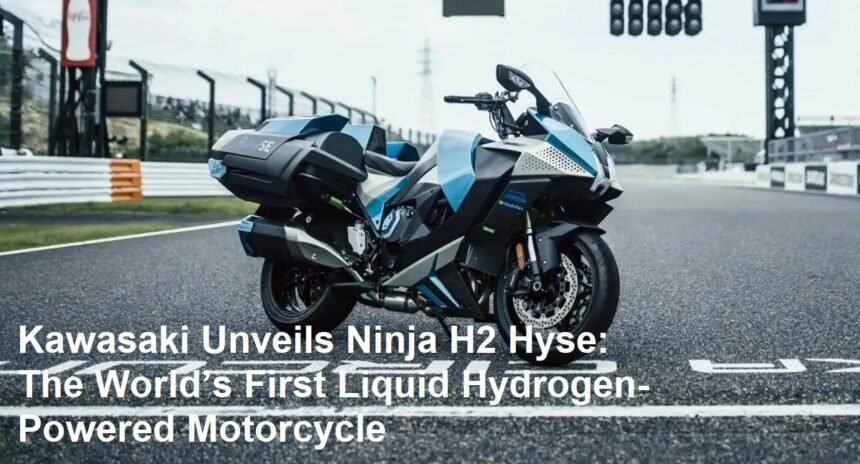Kawasaki has officially launched the Ninja H2 Hyse, marking a groundbreaking milestone in the motorcycle industry as the world’s first production motorcycle powered by liquid hydrogen. This innovative machine combines cutting-edge technology with environmental consciousness, showcasing Kawasaki’s commitment to sustainable mobility and advanced engineering.
The Ninja H2 Hyse is equipped with a powerful 998cc inline four-cylinder engine featuring a dual injection system specifically designed to utilize liquid hydrogen as its fuel source. This dual injection technology optimizes the combustion process by precisely controlling the delivery of hydrogen, ensuring efficient performance while minimizing emissions. The use of liquid hydrogen, rather than traditional gasoline or even compressed hydrogen gas, allows for greater energy density and longer riding range, addressing some of the key challenges faced by hydrogen-powered vehicles.
Liquid hydrogen as a fuel offers significant environmental benefits. When combusted, hydrogen produces water vapor as its primary emission, making it a zero-carbon fuel source. This aligns with global efforts to reduce greenhouse gas emissions and combat climate change. By pioneering a liquid hydrogen motorcycle, Kawasaki is pushing the boundaries of green technology in the two-wheeler segment, which has traditionally relied heavily on fossil fuels.
The engineering behind the Ninja H2 Hyse is a marvel of innovation. The 998cc inline four engine has been meticulously adapted to handle the unique properties of liquid hydrogen, which requires specialized fuel storage and delivery systems due to its extremely low temperature and high volatility. Kawasaki’s engineers developed advanced insulation and safety mechanisms to ensure the safe handling of liquid hydrogen onboard the motorcycle, making it practical for everyday use.
Performance-wise, the Ninja H2 Hyse promises to deliver the thrilling riding experience expected from the Ninja series. The inline four-cylinder engine, known for its smooth power delivery and high-revving capabilities, combined with the efficient hydrogen combustion, offers impressive acceleration and responsiveness. Riders can expect a blend of power and eco-friendliness without compromise.
The launch of the Ninja H2 Hyse also represents a strategic move in the broader context of the automotive and motorcycle industries’ transition toward alternative fuels. As governments worldwide tighten emissions regulations and consumers increasingly demand sustainable options, manufacturers are exploring hydrogen as a viable solution alongside electric powertrains. Kawasaki’s entry into liquid hydrogen technology positions the company as a leader in this emerging field.
Infrastructure development remains a critical factor for the adoption of hydrogen-powered vehicles. While hydrogen refueling stations are still limited globally, Kawasaki’s introduction of the Ninja H2 Hyse is likely to stimulate interest and investment in hydrogen infrastructure, particularly for motorcycles. The company’s initiative could encourage partnerships with energy providers and governments to expand refueling networks, making hydrogen motorcycles more accessible to consumers.
Beyond environmental and performance aspects, the Ninja H2 Hyse embodies Kawasaki’s dedication to innovation and pushing technological boundaries. The motorcycle serves as a testbed for future advancements in hydrogen fuel technology, potentially influencing other vehicle segments and inspiring further research and development.
The reception from the motorcycle community and environmental advocates has been largely positive, with many praising Kawasaki for taking bold steps toward sustainable mobility. The Ninja H2 Hyse not only offers a glimpse into the future of motorcycling but also challenges the industry to rethink traditional fuel paradigms.
In conclusion, Kawasaki’s launch of the Ninja H2 Hyse, the world’s first liquid hydrogen-powered motorcycle with a 998cc inline four dual injection engine, is a landmark achievement in both technology and environmental stewardship. It combines high performance with zero-emission fuel, setting a new standard for innovation in the motorcycle industry. As the world moves toward greener transportation solutions, Kawasaki’s pioneering effort with the Ninja H2 Hyse highlights the exciting possibilities of hydrogen fuel and the company’s role in shaping the future of sustainable riding.









